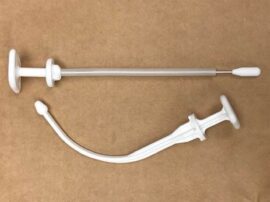Overmolding or insert molding? That’s the question for many medical device manufacturers who utilize plastic injection molding.
While similar, these two processes have a crucial difference: Overmolding creates two plastic components that are then molded together to form the final product. Insert molding takes a pre-fabricated component, often made of metal, then joins it to a plastic component which is molded over, under, or to the side, of the pre-fab part.

Why is insert molding so ideal for medical devices? Simply because many medical devices are composed of both metal and plastic, for utilitarian reasons. Surgical devices, for example, need a metal “business end” (think scalpels and stethoscopes) and a plastic, more “user friendly” handle, that is warmer and provides a better grip. Insert molding is the just the right prescription for that kind of application.
While insert molding adds complexity and development time to new products in the form of up-front tooling costs, it is often well-worth it, many medical device manufacturers say.
Molders use many different materials for several different medical applications. The major ones are:
- silicone glass-filled nylon over stainless-steel inserts
- silicone over PEEK
- polyurethanes over PC
- silicone on PC
- silicone over silicone
In addition, these resins are commonly used:
- PP
- TPE
- glass filled nylon
While insert molding is often the solution for producing plastic medical devices, there are parameters to consider. First, plastic medical device manufacturers should match the materials and methods of manufacture for the pre-fabricated insert with the secondary polymer materials and molding processes. These parameters include:
- temperature of tool
- structural deformation
- deformation from secondary material shrink
Several bonding methods are less expensive but they each have their own challenges. Adhesive bonding often pits aesthetic control over quality of bond. Sonic welding limits your selection of design and materials. Bonding or sonic welding of soft/flexible polymers or silicone is often extremely challenging.
Insert molding with silicone or flexible thermoplastic materials is usually the method of choice. Much more could be said but the bottom line is clear: insert molding is by far the healthiest choice for plastic medical devices!